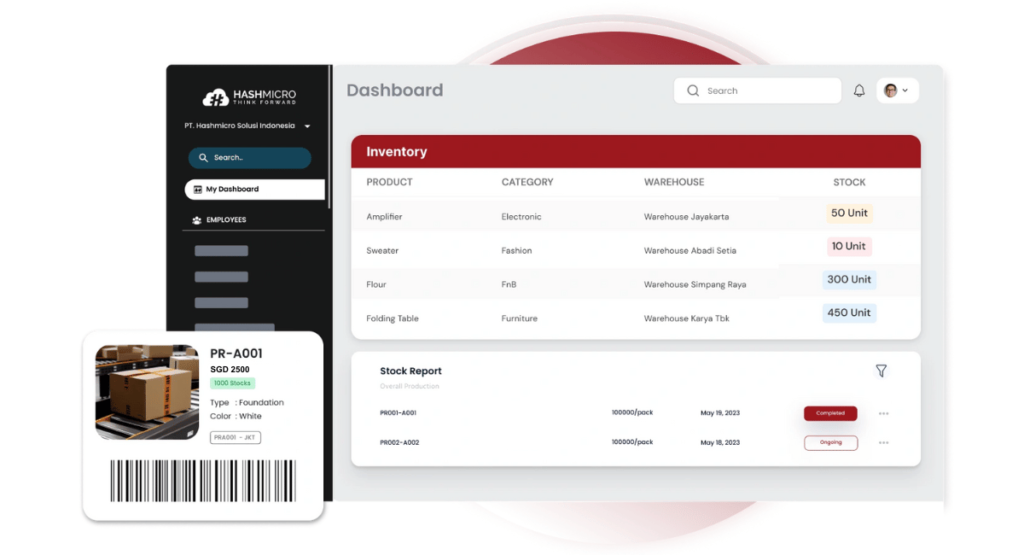Inventory management is an indispensable aspect of any successful business, and Singapore is no exception. With unique supply chain challenges, effective raw materials inventory management becomes even more critical for businesses to maintain profitability and meet market demands.
This comprehensive guide will delve into the importance of inventory management, provide an understanding of its fundamental concepts, and offer valuable insights and techniques tailored for Singaporean businesses to streamline their raw materials inventory management.
Let’s begin by exploring the significance of inventory management and its role in maintaining control over assets, cash flow, and overall business performance.
The Importance of Inventory Management
Effective inventory management is pivotal for businesses in Singapore to maintain a tight rein on their assets, cash flow, and overall operational efficiency. By implementing efficient inventory management practices, businesses can adeptly respond to market fluctuations, avoid the pitfalls of overstocking or understocking, and safeguard against losses due to damage, poor storage, or theft.
Inventory management is especially crucial in industries like construction, e-commerce, and retail, where inventory levels have a direct impact on sales and customer satisfaction. With optimized inventory control techniques, businesses can strike the perfect balance between meeting demand and minimizing unnecessary carrying costs or stockouts.
Moreover, inventory management empowers businesses to exert control over their supply chain and streamline operations. Effective management of raw material inventory improves production planning, reduces lead times, and enhances order fulfillment processes, ultimately contributing to a seamless and efficient supply chain.
For businesses in Singapore, where supply chain challenges are unique and ever-present, implementing effective raw materials inventory management strategies is not just an option but a necessity. By optimizing raw material inventory, businesses can minimize costs, enhance operational efficiency, and set themselves up for long-term success in a dynamic market environment.
Understanding Inventory Management
Inventory management is a critical component of efficient business operations. It involves the systematic tracking and control of inventory from the moment it is ordered until it is utilized or discarded.
This encompasses various processes, including receiving, stocking, consuming, and distributing materials, all coordinated within a seamless supply chain. By implementing effective inventory management techniques, businesses can ensure optimal stock levels, minimize losses, and meet market demands effectively.
Inventory management methods can range from basic manual systems, such as spreadsheets or stock cards, to more advanced digital solutions. While manual systems have their limitations, digital systems offer benefits such as barcode scanning and real-time reporting, providing businesses with accurate data and valuable insights.
The primary goal of inventory management is to find the delicate balance between having sufficient stock to satisfy customer demand and avoiding excess inventory that ties up valuable resources. By optimizing stock levels, businesses can reduce holding costs and minimize the risk of obsolescence or spoilage. Additionally, effective inventory management helps businesses navigate the complexities of supply chain management, logistics, storage, and information systems.
To excel at inventory management, businesses must adopt holistic approaches that integrate inventory management with other key areas, such as sales forecasting, production planning, and order management. This integration ensures a seamless flow of operations, enabling businesses to respond swiftly to market changes and enhance overall efficiency.
The Main Purpose of Inventory Management
Inventory management serves a crucial role in optimizing your supply chain and controlling costs. Efficient management of your inventory helps minimize spending on raw materials and goods, ensuring that you meet customer demand while generating revenue. However, the benefits of inventory management extend beyond cost control. It also fosters coordination among various departments, including sales, ordering, logistics, and accounting, resulting in a seamless and cohesive operation.
Streamlined inventory management practices, guided by efficient inventory control techniques, help you sidestep issues like overstocking, understocking, and stockouts, which can lead to financial losses and hinder business growth. By optimizing the balance between supply and demand and maintaining the right inventory levels at the right time, you can swiftly respond to market fluctuations, minimize stock obsolescence, and efficiently utilize working capital.
Efficient inventory management practices ensure your business is prepared to meet customer demands promptly and efficiently. By aligning different departments and implementing inventory control strategies, you can streamline the flow of materials, enhance productivity, and ultimately improve customer satisfaction.
How Inventory Management Works
The effectiveness of inventory management hinges on timely access to accurate and organized inventory data. This data forms the foundation for making informed decisions related to ordering, production, shipping, and storage. A robust inventory management system should capture, organize, and make this data readily accessible to all stakeholders in the supply chain, enabling optimal decision-making.
Inventory management systems should also generate reports that offer valuable insights into stock levels and trends. These reports help businesses identify patterns, anticipate demand fluctuations, and plan their inventory accordingly. Additionally, an effective system should facilitate stock level tracking, accurate demand forecasting, and demand planning to ensure timely replenishment.
By capturing and analyzing inventory data, businesses can identify areas for improvement, such as optimizing storage space or reducing carrying costs. With an optimized inventory management system in place, businesses can proactively address supply chain challenges, improve operational efficiency, and enhance overall profitability.
How to Manage Inventory Stocks
Managing your inventory stocks is pivotal for maintaining optimal stock levels and ensuring smooth operations. Different industries and scenarios call for different approaches, so it’s essential to tailor your inventory management strategies accordingly. Let’s explore some common inventory management techniques that can help you effectively manage your raw materials inventory.
Economic Order Quantity (EOQ)
The Economic Order Quantity (EOQ) method involves calculating the ideal order quantity to minimize inventory holding costs and order placement costs. By finding the perfect balance between holding costs and order costs, you can maintain efficient stock levels. This method ensures you order sufficient inventory to meet demand while minimizing excess stock.
Safety Stock Inventory
Safety stock inventory serves as a buffer against unexpected fluctuations in demand or supply chain disruptions. It is an additional quantity of inventory that provides insurance when demand surpasses expectations or there are delays in replenishing stock. By maintaining safety stock and calculating the safety stock formula, you can guarantee uninterrupted production and uphold customer satisfaction, even in unpredictable scenarios.
FIFO/LIFO Methods
The FIFO (First-In, First-Out) and LIFO (Last-In, First-Out) methods are inventory valuation techniques that dictate how costs are assigned to your inventory. FIFO assumes that the oldest inventory is sold first, while LIFO assumes that the newest inventory is sold first. These methods carry different tax implications and can impact your financial statements differently.
When choosing an inventory management approach, consider factors such as availability, demand patterns, worker availability, and market dynamics. By implementing effective inventory control techniques, you can optimize stock levels, minimize costs, and enhance your overall inventory management practices.
Types of Inventory and Their Management
Inventory takes on different forms depending on the industry and business type. It can encompass raw materials, work-in-progress items, finished goods, and even consumable products. Each type of inventory demands specific management techniques to ensure proper tracking, storage, and distribution. Businesses must understand the types of inventory they handle and develop tailored strategies for effective management. This may include implementing inventory control policies, setting reorder points, and establishing strong vendor relationships.
Proper management and categorization of different inventory types are crucial for optimizing raw material inventory and enhancing overall inventory management in Singapore. By considering the unique characteristics of each type of inventory and implementing customized management techniques, businesses can streamline operations, reduce costs, and effectively meet customer demands.
Best Practices for Efficient Inventory Management
To excel at inventory management, it is essential for businesses in Singapore to adhere to industry best practices. Proven techniques can help optimize stock levels, minimize costs, and enhance overall operations. By implementing the following practices, businesses can elevate their inventory control and achieve improved financial outcomes.
1. Accurate Data Capture and Organization: Ensure timely and accurate capturing of inventory data, including quantities, locations, and expiration dates. Organize this information in a centralized system for easy access and retrieval, facilitating efficient inventory tracking and analysis.
2. Effective Forecasting and Demand Planning: Utilize historical data, market trends, and demand forecasting techniques to anticipate customer demand accurately. This enables optimal stock levels, prevents overstocking or understocking, and enhances order fulfillment capabilities.
3. Regular Inventory Audits: Conduct routine inventory audits to identify discrepancies, monitor stock accuracy, and reduce the risk of stockouts or excess inventory. Regular audits ensure prompt identification and rectification of inventory issues, maintaining data integrity and efficient inventory management.
4. Efficient Order Management: Streamline the order management process to ensure timely order fulfillment and minimize order errors. Utilize automated order management systems to facilitate accurate order processing and improve customer satisfaction.
5. Streamlined Logistics and Transportation: Optimize logistics and transportation processes to reduce lead times, minimize transportation costs, and improve delivery reliability. Collaborate closely with logistics partners to streamline supply chain operations and enhance overall efficiency.
6. Cross-Functional Collaboration: Foster collaboration between departments such as sales, procurement, and operations to ensure effective coordination and alignment. Regular communication and information sharing lead to more accurate demand planning and improved inventory control.
By embracing these best practices, businesses in Singapore can optimize their stock levels, reduce costs, and enhance overall operations. Efficient inventory management is the cornerstone of maintaining a competitive edge and meeting customer demands in Singapore’s dynamic business landscape.
Tools and Resources for Inventory Management
To excel at inventory management, it is advantageous to leverage a range of tools and resources. These tools include advanced inventory management software, barcode scanners, and other innovative gadgets. By utilizing these technologies, you can streamline inventory control processes and gain deeper visibility into your stock levels.
Inventory management software is an invaluable tool that automates manual processes, provides real-time inventory tracking, and generates insightful reports. It also offers features such as demand forecasting and order management, aiding in informed decision-making.
In addition to software solutions, educational resources, such as guides and articles by industry experts, can provide valuable tips and techniques for optimizing inventory control. Staying abreast of the latest trends and best practices ensures that you make well-informed decisions about your inventory management strategies.
Furthermore, seeking professional advice and consulting services can offer expert insights into inventory management strategies tailored to your business needs. Consultants can assess your current practices, identify areas for improvement, and guide you in implementing efficient inventory management techniques.
By harnessing the power of these tools and resources, you can enhance your inventory management practices and achieve better control over your raw materials inventory. Whether it’s investing in specialized software, staying informed, or seeking expert advice, the right tools can significantly impact your inventory control processes.
Conclusion
Efficient raw materials inventory management is crucial for businesses in Singapore to maintain profitability and manage their supply chain effectively. By following industry best practices, utilizing advanced inventory management software like HashMicro, and employing effective inventory control techniques, businesses can enhance overall operations.
HashMicro’s inventory software provides real-time visibility, streamlines inventory control processes, and offers flexibility and scalability to meet the specific needs of various industries. As businesses evolve, HashMicro’s solution can scale accordingly, ensuring efficient inventory management.
Additionally, HashMicro offers dedicated support, providing users with a reliable partner for successful implementation and ongoing assistance, underscoring their commitment to their clients’ success.
Are you interested? Register for a free demo and get the chance to experience the software directly!



































